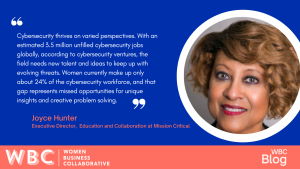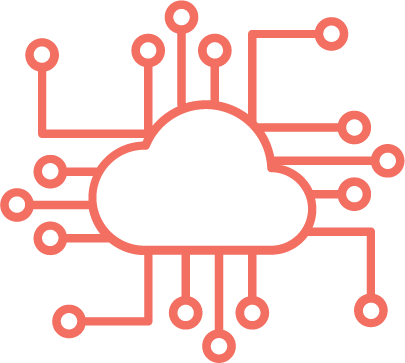
In today’s digital-first world, cybersecurity is more than a technical requirement; it is a fundamental aspect of business resilience, trust, and innovation. However, as cyber threats become more sophisticated, organizations need diverse and innovative approaches to tackle these challenges effectively. Women Business Collaborative (WBC) is committed to advocating for gender diversity across industries, and cybersecurity is no exception. For National Cybersecurity Month, we’re exploring why diversity, especially the inclusion of women, is essential for cybersecurity innovation.
Why Gender Diversity Matters in Cybersecurity
Cybersecurity thrives on varied perspectives. With an estimated 3.5 million unfilled cybersecurity jobs globally, according to Cybersecurity Ventures, the field needs new talent and ideas to keep up with evolving threats. Women currently make up only about 24% of the cybersecurity workforce, and that gap represents missed opportunities for unique insights and creative problem-solving. Studies show that diverse teams are more innovative, bringing distinct viewpoints that foster fresh solutions to complex problems. In cybersecurity, this diversity of thought is particularly important. Diverse teams are often better at identifying vulnerabilities and developing forward-thinking defenses.
How Women in Cybersecurity Drive Innovation
Women in cybersecurity often bring new ideas that lead to impactful changes and solutions. They add to the diversity of thought and approach problems from different perspectives, which can lead to breakthrough strategies in threat prevention and response. For instance, women-led teams are known for emphasizing collaborative problem-solving and adopting a comprehensive approach to cybersecurity, which can enhance an organization’s overall resilience.
One example is Diana Kelley, co-founder and CTO of Security Curve, who has contributed innovative ideas to cybersecurity risk management and threat detection. Women like Kelley bring fresh perspectives that drive the industry forward, proving that including women in cybersecurity isn’t just about fairness—it’s about creating stronger, more adaptable defenses.
The Role of WBC in Advancing Women in Cybersecurity
Women’s Business Collaborative (WBC) believes that gender diversity in all areas, especially cybersecurity, is vital for industry advancement. WBC supports gender equity in leadership and promotes initiatives to empower women in business through collaboration, education, and advocacy. By working with partners in the cybersecurity field, WBC seeks to close the gender gap and drive the growth of innovative solutions to cybersecurity challenges.
Some of the ways WBC helps bridge the gender gap in cybersecurity include:
- Supporting Mentorship Programs – By promoting mentorship and sponsorship, WBC helps women find and leverage resources to grow their cybersecurity careers, learn critical skills, and gain leadership opportunities.
- Encouraging STEM Education – WBC advocates for young girls and women to be exposed to early STEM (Science, Technology, Engineering, and Mathematics) to foster interest and competence in cybersecurity-related fields.
- Championing Women Leaders – WBC highlights women’s achievements in cybersecurity, offering visibility to women leaders and encouraging others to enter and excel in the field.
The Call to Action: Building a More Inclusive Cybersecurity Future
Organizations need to recognize that gender diversity isn’t just a matter of representation; it’s a strategic advantage. Diverse teams are essential to crafting resilient, innovative solutions that withstand today’s complex cyber threats. Companies can actively contribute by creating an inclusive environment that values diverse perspectives and backgrounds.
Now, more than ever, companies and industry leaders must work together to ensure women have equal opportunities to contribute to and shape the future of cybersecurity. As WBC continues to advocate for gender parity across business sectors, we invite all organizations to join us in supporting women in cybersecurity.
We must work together to build a more secure and innovative future.** Embracing diversity, particularly gender diversity, isn’t just a step toward equity—it’s a necessary strategy for success in today’s digital landscape. By fostering an inclusive, diverse workforce, we can drive the innovation needed to face and overcome tomorrow’s cybersecurity challenges.








